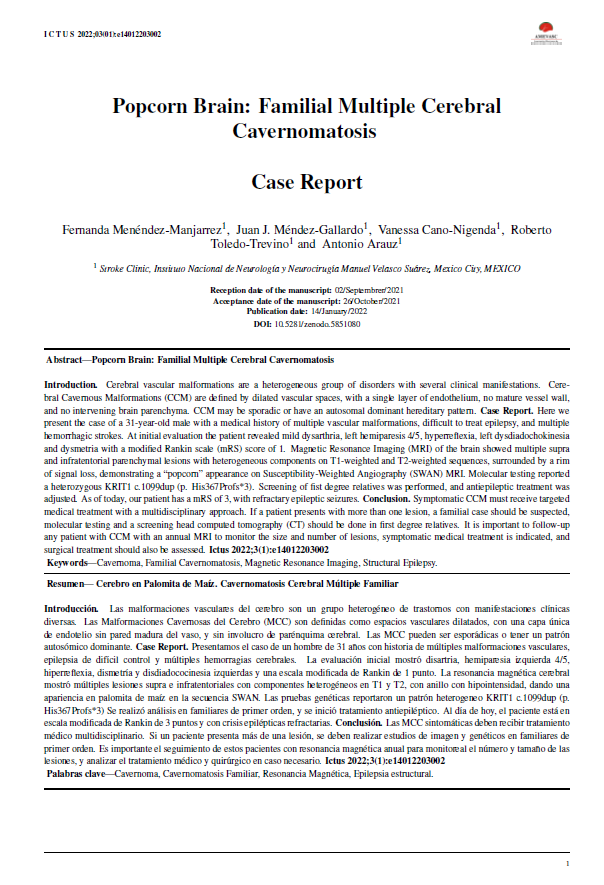Abstract
Introduction. Cerebral vascular malformations are a heterogeneous group of disorders with several clinical manifestations. Cerebral Cavernous Malformations (CCM) are defined by dilated vascular spaces, with a single layer of endothelium, no mature vessel wall, and no intervening brain parenchyma. CCM may be sporadic or have an autosomal dominant hereditary pattern. Case Report. Here we present the case of a 31-year-old male with a medical history of multiple vascular malformations, difficult to treat epilepsy, and multiple hemorrhagic strokes. At initial evaluation the patient revealed mild dysarthria, left hemiparesis 4/5, hyperreflexia, left dysdiadochokinesia and dysmetria with a modified Rankin scale (mRS) score of 1. Magnetic Resonance Imaging (MRI) of the brain showed multiple supra and infratentorial parenchymal lesions with heterogeneous components on T1-weighted and T2-weighted sequences, surrounded by a rim of signal loss, demonstrating a “popcorn” appearance on Susceptibility-Weighted Angiography (SWAN) MRI. Molecular testing reported a heterozygous KRIT1 c.1099dup (p. His367Profs*3). Screening of fist degree relatives was performed, and antiepileptic treatment was adjusted. As of today, our patient has a mRS of 3, with refractary epileptic seizures. Conclusion. Symptomatic CCM must receive targeted medical treatment with a multidisciplinary approach. If a patient presents with more than one lesion, a familial case should be suspected, molecular testing and a screening head computed tomography should be done in first degree relatives. It is important to follow-up any patient with CCM with an annual MRI to monitor the size and number of lesions, symptomatic medical treatment is indicated, and surgical treatment should also be assessed.
References
Cutaneous venous malformations in familial cerebral cavernomatosis caused by KRIT1 gene mutations. Dermatology. 2009;218(4):307–13.
Awad IA, Polster SP. Cavernous angiomas: Deconstructing a neurosurgical disease: JNSPG 75th Anniversary Invited Review Article. J Neurosurg. 2019;131(1):1–13.
Stapleton CJ, Barker FG. Cranial cavernous malformations natural history and treatment. Stroke. 2018;49(4):1029–35.
Mondejar R, Lucas M. Molecular diagnosis in cerebral cavernous malformations. Neurol (English Ed. 2017;32(8):540–5.
Labauge P, Denier C, Bergametti F, Tournier-Lasserve E. Genetics of cavernous angiomas. Lancet Neurol. 2007;6(3):237–44.
Bokhari MR, Al-Dhahir MA. Brain Cavernous Angiomas [Internet]. StatPearls [Internet]. 2021. Available from: https://www.ncbi.nlm.nih.gov/books/NBK430871/
Morrison L, Akers A. Cerebral Cavernous Malformation , Familial Summary Genetic counseling Diagnosis Suggestive Findings. GeneReviews. 2003;1993–2021.
Choquet H, Pawlikowska L, Lawton MT, Kim H. Genetics of Cerebral Cavernous Malformations: Current Status and Future Prospects. J Neurosurg Sci [Internet]. 2016;59(3):211–20. Available from: https://www.ncbi.nlm.nih.gov/pmc/articles/PMC4461471/
Rosenow F, Alonso-Vanegas MA, Baumgartner C, Blümcke I, Carreño M, Gizewski ER, et al. Cavernoma-related epilepsy: Review and recommendations for management - Report of the Surgical Task Force of the ILAE Commission on Therapeutic Strategies. Epilepsia. 2013;54(12):2025–35.
Chalouhi N, Jabbour P, Andrews DW. Stereotactic radiosurgery for cavernous malformations: Is it effective? World Neurosurg. 2013;80(6):987–91.

This work is licensed under a Creative Commons Attribution 4.0 International License.
Copyright (c) 2022 Ictus

